中国传统艺术中英文介绍 sophia
- 格式:ppt
- 大小:13.25 MB
- 文档页数:48
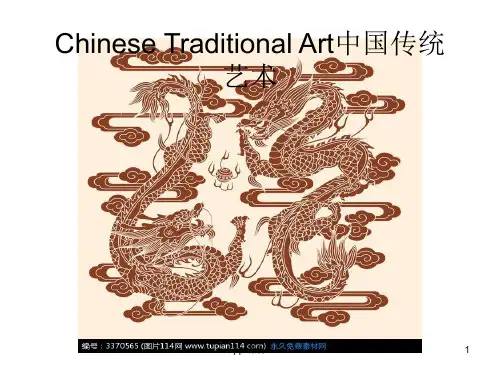
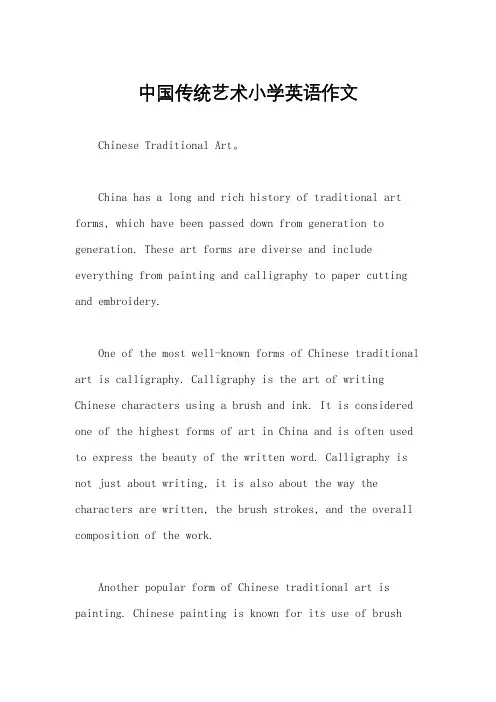
中国传统艺术小学英语作文Chinese Traditional Art。
China has a long and rich history of traditional art forms, which have been passed down from generation to generation. These art forms are diverse and include everything from painting and calligraphy to paper cutting and embroidery.One of the most well-known forms of Chinese traditional art is calligraphy. Calligraphy is the art of writing Chinese characters using a brush and ink. It is considered one of the highest forms of art in China and is often used to express the beauty of the written word. Calligraphy is not just about writing, it is also about the way the characters are written, the brush strokes, and the overall composition of the work.Another popular form of Chinese traditional art is painting. Chinese painting is known for its use of brushand ink, as well as its emphasis on capturing the essenceof the subject rather than just its appearance. Chinese painting often features landscapes, flowers, and birds, and is often used to convey a sense of tranquility and harmony.Paper cutting is another traditional art form in China. It involves cutting intricate designs out of paper using scissors or a knife. Paper cutting is often used to create decorative items such as window ornaments, lanterns, andwall hangings.Embroidery is yet another traditional art form in China. It involves stitching intricate designs onto fabric using a needle and thread. Chinese embroidery is known for its useof bright colors and intricate patterns, and is often usedto create clothing, accessories, and home decor items.Overall, Chinese traditional art forms are an important part of China's cultural heritage and continue to be celebrated and practiced today. They are not only beautiful to look at, but also reflect the values and beliefs of Chinese culture.。
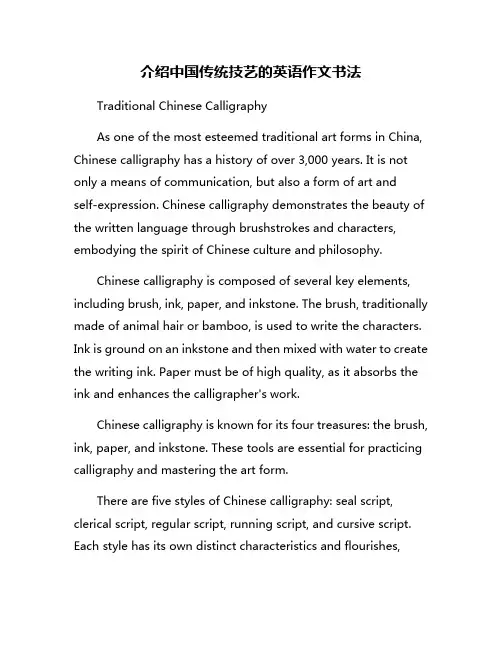
介绍中国传统技艺的英语作文书法Traditional Chinese CalligraphyAs one of the most esteemed traditional art forms in China, Chinese calligraphy has a history of over 3,000 years. It is not only a means of communication, but also a form of art andself-expression. Chinese calligraphy demonstrates the beauty of the written language through brushstrokes and characters, embodying the spirit of Chinese culture and philosophy.Chinese calligraphy is composed of several key elements, including brush, ink, paper, and inkstone. The brush, traditionally made of animal hair or bamboo, is used to write the characters. Ink is ground on an inkstone and then mixed with water to create the writing ink. Paper must be of high quality, as it absorbs the ink and enhances the calligrapher's work.Chinese calligraphy is known for its four treasures: the brush, ink, paper, and inkstone. These tools are essential for practicing calligraphy and mastering the art form.There are five styles of Chinese calligraphy: seal script, clerical script, regular script, running script, and cursive script. Each style has its own distinct characteristics and flourishes,allowing the calligrapher to express their emotions and thoughts through their writing.Calligraphy plays an essential role in Chinese culture and history. It is often used in official documents, poetry, and art pieces. Calligraphy is also a way for individuals to cultivate their character and discipline. By practicing calligraphy, one can learn patience, concentration, and humility.In conclusion, Chinese calligraphy is a revered art form that has been passed down through generations. It embodies the beauty and elegance of the Chinese language and culture. Through its brushstrokes and characters, calligraphy captures the essence of Chinese philosophy and tradition.。
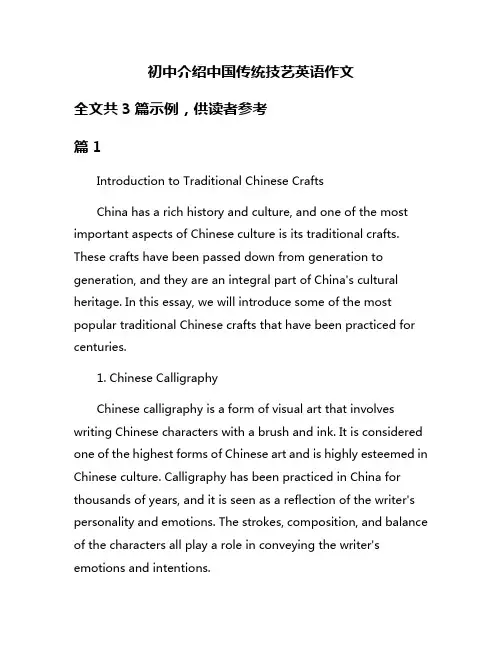
初中介绍中国传统技艺英语作文全文共3篇示例,供读者参考篇1Introduction to Traditional Chinese CraftsChina has a rich history and culture, and one of the most important aspects of Chinese culture is its traditional crafts. These crafts have been passed down from generation to generation, and they are an integral part of China's cultural heritage. In this essay, we will introduce some of the most popular traditional Chinese crafts that have been practiced for centuries.1. Chinese CalligraphyChinese calligraphy is a form of visual art that involves writing Chinese characters with a brush and ink. It is considered one of the highest forms of Chinese art and is highly esteemed in Chinese culture. Calligraphy has been practiced in China for thousands of years, and it is seen as a reflection of the writer's personality and emotions. The strokes, composition, and balance of the characters all play a role in conveying the writer's emotions and intentions.2. Chinese PaintingChinese painting is another important traditional craft in China. It incorporates the use of ink and brush to create beautiful and expressive images on paper or silk. Chinese painting often features landscapes, flowers, birds, and other natural elements, and it is known for its delicate brushwork and use of color. Like calligraphy, Chinese painting is considered a form ofself-expression, and artists often use it to convey their feelings and thoughts.3. Chinese EmbroideryChinese embroidery is a traditional craft that involves stitching intricate designs onto fabric using colorful threads. It is a highly skilled art form that requires precision and attention to detail. Chinese embroidery has a long history and has been used to decorate clothing, accessories, and household items. Each region in China has its own unique style of embroidery, and some of the most famous types include Suzhou embroidery and Hunan embroidery.4. Chinese Paper CuttingChinese paper cutting is a traditional folk art that involves cutting intricate designs out of paper. These designs are oftenused to decorate windows, doors, and walls during festivals and celebrations. Chinese paper cutting is believed to bring good luck and ward off evil spirits, and it is a popular craft among Chinese people of all ages. The designs are typically based on Chinese symbols, animals, and flowers, and they can be very elaborate and detailed.5. Chinese PotteryPottery has been an important traditional craft in China for thousands of years. Chinese potters are known for their exquisite handiwork and innovative techniques. Chinese pottery can be made from a variety of materials, including porcelain, stoneware, and earthenware. Some of the most famous styles of Chinese pottery include celadon, blue and white porcelain, and Yixing clay teapots. Chinese pottery is not only functional but also decorative, and it is highly valued in Chinese culture.In conclusion, traditional Chinese crafts are a significant part of China's cultural heritage and have played an important role in shaping Chinese society. These crafts reflect the creativity, skill, and ingenuity of the Chinese people, and they continue to be valued and practiced to this day. By preserving and promoting these traditional crafts, we can ensure that they will be passed down to future generations and continue to enrich our lives.篇2Introduction to Traditional Chinese CraftsChina is known for its rich history and cultural heritage, which includes a wide variety of traditional crafts that have been passed down from generation to generation. These traditional crafts showcase the artistic and cultural achievements of the Chinese people and continue to be a source of pride for the nation.One of the most well-known traditional crafts in China is porcelain making. Chinese porcelain has a long history dating back to the Eastern Han Dynasty (25-220 AD) and is highly prized for its delicate beauty and intricate designs. The art of porcelain making involves shaping clay into various forms, firing them in a kiln at high temperatures, and decorating them with colorful glazes. Some of the most famous Chinese porcelain styles include blue and white porcelain from Jingdezhen and famille rose porcelain from the Qing Dynasty.Another traditional craft that China is famous for is silk weaving. Silk production has been a major industry in China for thousands of years, with the country being the first to discover and cultivate silkworms. Chinese silk is renowned for its softness,sheen, and durability, and is used to create a wide range of products such as clothing, accessories, and home décor. The process of silk weaving involves raising silkworms, harvesting their cocoons, unraveling the silk threads, and weaving them into fabric using traditional looms. Some of the most famous Chinese silk products include silk robes, scarves, and tapestries.Chinese paper cutting is another traditional craft that has been practiced for centuries. Paper cutting involves using scissors to cut intricate designs into paper, creating beautiful patterns and images. This art form is often used to decorate homes during festivals and celebrations, with designs featuring symbols of good luck, prosperity, and happiness. Chinese paper cutting is a highly skilled craft that requires precision, patience, and creativity, and is a popular form of folk art in China.Chinese calligraphy is a traditional art form that dates back thousands of years and is considered a form of visual art in China. Calligraphy involves using a brush and ink to write Chinese characters in a fluid and expressive manner, creating a work of art that is both beautiful and meaningful. Chinese calligraphy is highly valued for its aesthetic appeal, with different styles and techniques reflecting the individuality and creativity of the artist. Calligraphy is often used to write poems, letters, and other formsof written communication, and is considered a vital part of Chinese culture.In conclusion, traditional Chinese crafts are an important part of the nation's cultural heritage and showcase the artistic achievements of the Chinese people. These crafts have been passed down through generations and continue to be practiced and celebrated for their beauty, skill, and cultural significance. By preserving and promoting traditional crafts, China is able to connect with its rich history and uphold its cultural traditions for future generations to enjoy.篇3Introduction to Traditional Chinese Arts and CraftsChina, with its rich history and diverse culture, has a long and proud tradition of arts and crafts that date back thousands of years. These traditional skills and techniques have been passed down from generation to generation, and continue to have a significant impact on Chinese culture and society. In this essay, we will explore some of the most prominent traditional Chinese arts and crafts, and their importance in preserving the cultural heritage of the country.One of the most well-known traditional Chinese art forms is calligraphy. Dating back to ancient times, calligraphy is considered one of the highest forms of visual art in China. It involves the writing of Chinese characters using a brush and ink, and requires a high level of skill and precision. Calligraphy is not only a form of artistic expression, but also a means of communication and self-improvement. Many Chinese people still practice calligraphy as a way to cultivate their character and express their feelings.Another popular traditional Chinese craft is paper cutting. Paper cutting involves the intricate cutting of paper into various shapes and designs, often depicting animals, flowers, and other motifs. This art form has a long history in China, and is often used for decorative purposes during holidays and special occasions. Paper cutting requires a steady hand and sharp scissors, and the finished pieces are often delicate and beautiful.Chinese embroidery is another traditional craft that has been passed down through the ages. Embroidery involves the stitching of decorative designs onto fabric using colored threads, and can be found on clothing, accessories, and household items. Chinese embroidery is known for its intricate patterns, vibrant colors, and exquisite craftsmanship. Many traditional Chinesegarments, such as cheongsams and silk robes, are adorned with intricate embroidery, showcasing the skill and artistry of the craft.Traditional Chinese painting, known as ink wash painting, is a highly regarded art form that dates back to ancient times. Ink wash painting involves the use of black ink and water to create brushstrokes that convey emotion and beauty. This art form often depicts landscapes, flowers, birds, and other natural subjects, and is characterized by its simplicity and elegance. Chinese painting has had a profound influence on other art forms, such as Japanese sumi-e painting and Korean watercolor painting.In addition to these traditional arts and crafts, China is also known for its ceramics, porcelain, jade carving, and other forms of traditional craftsmanship. These skills have been honed over centuries, and continue to be practiced and celebrated in modern-day China. Traditional Chinese arts and crafts are a testament to the creativity, skill, and cultural vitality of the Chinese people, and play an important role in preserving the country's rich heritage.In conclusion, traditional Chinese arts and crafts are an integral part of Chinese culture and society. These ancient skillsand techniques have been passed down through the generations, and continue to be practiced and appreciated in modern-day China. From calligraphy and paper cutting to embroidery and painting, traditional Chinese arts and crafts are a reflection of the country's long and storied history, and a source of pride for the Chinese people. Through the preservation and promotion of these traditional art forms, China can continue to showcase its cultural heritage and artistic legacy to the world.。

中国的非物质文化遗产介绍英文段落一:Chinese Calligraphy (中国书法)Chinese Calligraphy, known as "Shufa" in Chinese, is an art form that transcends mere writing. It embodies the harmony between strokes, ink, and paper, reflecting the calligrapher's personality, emotions, and philosophical insights. Each character is a microcosm of balance, rhythm, and vitality, making calligraphy not only a means of communication but also a profound aesthetic experience. As a spiritual pursuit, it has been deeply ingrained in Chinese society for over 3,000 years, fostering virtues such as patience, concentration, and self-cultivation.Chinese Calligraphy (中国书法)Chinese Calligraphy, or “Shufa”in Chinese, transcends mere writing as an art form. It harmoniously unites strokes, ink, and paper, mirroring the calligrapher’s personality, emotions, and philosophical insights. Each character embodies balance, rhythm, and vitality, rendering calligraphy not only a mode of communication but also a profound aesthetic experience. For over 3,000 years,it has been deeply rooted in Chinese society as a spiritual pursuit, nurturing virtues like patience, concentration, and self-cultivation.段落二:Peking Opera (京剧)Peking Opera, or "Jingju" in Chinese, is a theatrical spectacle combining singing, recitation, acting, martial arts, and acrobatics. Its distinctive makeup, costumes, and gestures convey complex characters and narratives, often drawn from historical events, myths, and legends. With a history spanning more than 200 years, Peking Opera has evolved into a national symbol, representing the pinnacle of Chinese operatic art. It continues to captivate audiences worldwide with its vivid storytelling, exquisite music, and profound cultural significance.Peking Opera (京剧)Peking Opera, known as “Jingju” in Chinese, is a theatrical extravaganza integrating singing, recitation, acting, martial arts, and acrobatics. Distinctive makeup, costumes, and gestures convey intricate characters and narratives, often derived from historical events, myths, and legends. Over 200 years old, Peking Opera has becomea national emblem, embodying the apex of Chinese operatic art. It enthralls global audiences with its vivid storytelling, sublime music, and profound cultural import.段落三:Dragon Boat Festival (端午节)The Dragon Boat Festival, or "Duanwu Jie" in Chinese, is a time-honored celebration held annually on the fifth day of the fifth lunar month. It commemorates the ancient poet Qu Yuan and his unwavering loyalty to his country. The festival is marked by vibrant dragon boat races, where teams paddle furiously to the beat of drums, symbolizing attempts to rescue Qu Yuan from the river. Additionally, Zongzi –glutinous rice dumplings wrapped in bamboo leaves –are enjoyed as a traditional delicacy. This festive occasion encapsulates China's respect for history, reverence for ancestors, and commitment to preserving cultural heritage.Dragon Boat Festival (端午节)The Dragon Boat Festival, or “Duanwu Jie” in Chinese, is an age-old celebration observed annually on the fifth day of the fifth lunar month. It honors the ancient poet Qu Yuan and his steadfast devotion to his homeland.Characterized by energetic dragon boat races, where teams paddle in sync with drumbeats, symbolizing efforts to save Qu Yuan from the river, the festival also features Zongzi —glutinous rice dumplings wrapped in bamboo leaves—as a traditional treat. This jubilant event exemplifies China’s respect for history, veneration of ancestors, and dedication to cultural preservation.段落四:Paper-cutting (剪纸)Paper-cutting, or "Jianzhi" in Chinese, is a delicate folk art that dates back to the 6th century. Artists use scissors or knives to intricately cut patterns and images on red paper, symbolizing good fortune and happiness. These vibrant creations, often depicting auspicious symbols, flora, fauna, or scenes from daily life, adorn windows, doors, and walls during festivals or special occasions. Paper-cutting reflects the Chinese people's appreciation for beauty, symmetry, and symbolism, as well as their ability to transform simple materials into extraordinary expressions of cultural identity.Paper-cutting (剪纸)Paper-cutting, or “Jianzhi” in Chinese, is a refinedfolk art with roots dating back to the 6th century. Using scissors or knives, artists skillfully cut intricate patterns and images onto red paper, signifying good luck and joy. Vibrant designs, frequently portraying auspicious symbols, plants, animals, or everyday scenes, embellish windows, doors, and walls during festivals or special events. This artform mirrors the Chinese populace’s admiration for beauty, symmetry, and symbolism, as well as their talent for transforming humble materials into extraordinary manifestations of cultural identity.In conclusion, China's intangible cultural heritage is a treasure trove of artistic expression, historical narrative, and communal spirit. From the graceful lines of calligraphy to the dramatic spectacle of Peking Opera, from the festive traditions of the Dragon Boat Festival to the intricate charm of paper-cutting, each element contributes to the rich tapestry of Chinese culture. These living legacies continue to thrive, evolve, and inspire, serving as vital links to the past while enriching the present and future of Chinese society and humanity at large.总结China's intangible cultural heritage is a wealth ofartistic expression, historical narrative, and communal spirit. Spanning from the elegant strokes of calligraphy to the theatrical grandeur of Peking Opera, from the festive customs of the Dragon Boat Festival to the delicate allure of paper-cutting, each facet adds to the diverse fabric of Chinese culture. These dynamic traditions persist, adapt, and motivate, functioning as crucial connections to the past while enhancing the present and future of both Chinese society and humanity writ large.。
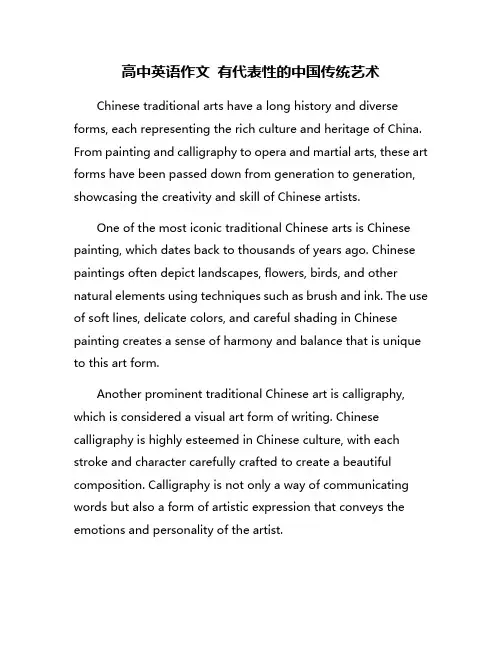
高中英语作文有代表性的中国传统艺术Chinese traditional arts have a long history and diverse forms, each representing the rich culture and heritage of China. From painting and calligraphy to opera and martial arts, these art forms have been passed down from generation to generation, showcasing the creativity and skill of Chinese artists.One of the most iconic traditional Chinese arts is Chinese painting, which dates back to thousands of years ago. Chinese paintings often depict landscapes, flowers, birds, and other natural elements using techniques such as brush and ink. The use of soft lines, delicate colors, and careful shading in Chinese painting creates a sense of harmony and balance that is unique to this art form.Another prominent traditional Chinese art is calligraphy, which is considered a visual art form of writing. Chinese calligraphy is highly esteemed in Chinese culture, with each stroke and character carefully crafted to create a beautiful composition. Calligraphy is not only a way of communicating words but also a form of artistic expression that conveys the emotions and personality of the artist.Chinese opera, also known as Peking opera, is a traditional Chinese art form that combines music, dance, and acting. The colorful costumes, elaborate makeup, and stylized movements of Chinese opera performers make it a visually captivating experience. Peking opera performances often feature historical stories, legends, and myths, providing a glimpse into Chinese history and culture.Martial arts, such as kung fu and tai chi, are also important traditional Chinese arts that have gained international recognition. These martial arts not only emphasize physical strength and agility but also focus on mental discipline and spiritual development. Practitioners of martial arts are trained to master various techniques and forms, demonstrating the beauty and power of Chinese martial arts.In addition to these traditional arts, Chinese handicrafts such as paper-cutting, embroidery, and porcelain making are also highly regarded for their intricate designs and exquisite craftsmanship. These handicrafts reflect the creativity and dedication of Chinese artisans, who continue to preserve and promote these traditional art forms.Overall, Chinese traditional arts are a reflection of China's rich cultural heritage and artistic legacy. These art formscontinue to inspire and captivate audiences around the world, showcasing the beauty, creativity, and diversity of Chinese culture. As we appreciate and celebrate these traditional arts, we honor the talents and traditions of Chinese artists who have preserved these art forms for future generations to enjoy.。
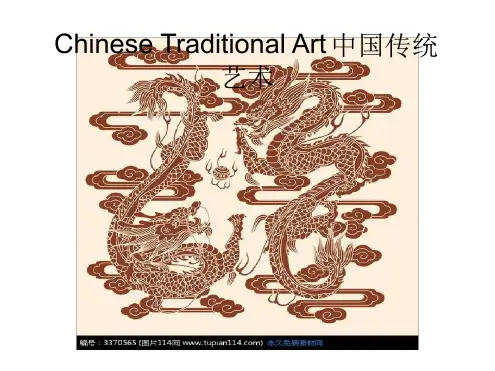

我国传统艺术作为中华民族灿烂文化的重要组成部分,历经千年传承发展,积淀了丰富的艺术成果,既有绘画、书法、音乐、舞蹈等视觉艺术形式,也包括戏曲、民间艺术、工艺美术等非物质文化遗产,堪称是我国文化的瑰宝。
以下将对我国传统艺术进行简要介绍。
1. 绘画我国绘画以山水、花鸟、人物为主要表现对象,倡导“意境”的表现,注重笔墨的运用和意境的表达,形成了独特的艺术风格。
著名画家有吴道子、顾恺之、文征明等。
2. 书法我国书法是我国传统艺术的重要组成部分,包括隶书、楷书、行书、草书等不同字体,强调“气韵生动”和“笔墨情致”,被誉为“东方艺术之花”。
3. 音乐我国传统音乐源远流长,有丰富的曲调和独特的器乐演奏方式,代表作品有《广陵散》、《梁祝》等经典曲目。
4. 戏曲我国戏曲包括京剧、豫剧、越剧等多种剧种,以华彩多姿的脸谱和独特的唱腔、表演形式而闻名,被誉为“我国百戏之祖”。
5. 舞蹈我国舞蹈以舞姿轻盈、优美动人而著称,有古典舞、民间舞等多个流派,具有独特的审美价值。
6. 工艺美术我国工艺美术包括瓷器、丝绸、漆器、刺绣等多个门类,历史悠久,工艺精湛,艺术价值极高。
我国传统艺术作为中华民族的文化瑰宝,不仅在国内得到传承和发展,也在国际上产生了广泛而深远的影响,为世界文化艺术宝库增添了璀璨的一笔。
希望在今后的文化交流中,能够进一步推广和弘扬我国传统艺术,让世界更加了解和欣赏我国文化的博大精深。
我国传统艺术是我国文化的瑰宝,它体现了中华民族悠久的历史和深厚的文化底蕴。
我国传统艺术所蕴含的价值和魅力,不仅体现在其独特的审美形式上,更体现在对人类精神追求和人文情感的深刻表达。
以下将进一步展开介绍和探讨我国传统艺术的多个方面。
一、我国传统绘画我国传统绘画源远流长,其独特的艺术表现形式和审美理念对我国绘画的发展产生了深远影响。
古代绘画作品以山水、花鸟和人物为主题,形成了独特的审美观念和绘画风格。
我国古代山水画强调“以意写形”,通过丰富的意境和情感表达来展现自然山水的壮美和神韵。
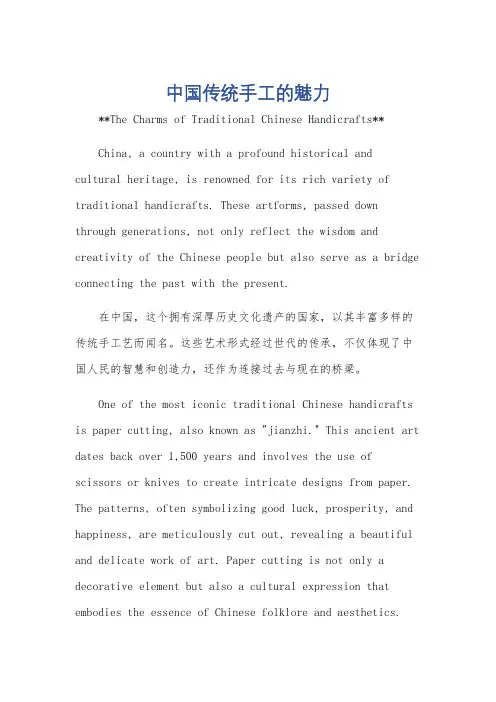
中国传统手工的魅力**The Charms of Traditional Chinese Handicrafts**China, a country with a profound historical andcultural heritage, is renowned for its rich variety of traditional handicrafts. These artforms, passed down through generations, not only reflect the wisdom and creativity of the Chinese people but also serve as a bridge connecting the past with the present.在中国,这个拥有深厚历史文化遗产的国家,以其丰富多样的传统手工艺而闻名。
这些艺术形式经过世代的传承,不仅体现了中国人民的智慧和创造力,还作为连接过去与现在的桥梁。
One of the most iconic traditional Chinese handicrafts is paper cutting, also known as "jianzhi." This ancient art dates back over 1,500 years and involves the use of scissors or knives to create intricate designs from paper. The patterns, often symbolizing good luck, prosperity, and happiness, are meticulously cut out, revealing a beautiful and delicate work of art. Paper cutting is not only a decorative element but also a cultural expression that embodies the essence of Chinese folklore and aesthetics.中国传统手工艺中最具标志性的之一是剪纸,也被称为“剪纸”。

介绍中国传统的手艺艺术英语作文Traditional Chinese HandicraftsHave you ever wondered how beautiful things like silk robes, porcelain vases, or jade carvings are made? These are just a few examples of the amazing handicrafts that skilled artisans in China have been creating for centuries using special techniques passed down through many generations. Let me tell you about some of the most famous traditional Chinese handicrafts!Silk ProductionOne of the most renowned Chinese handicrafts issilk-making. Did you know the secret of silk was kept hidden from the rest of the world for thousands of years? In ancient China, only specially trained people were allowed to work with silkworms and weave silk thread into luxurious fabrics.The process all starts with the tiny silkworm. These little caterpillar-like creatures munch on fresh mulberry leaves day and night. Eventually, they spin cocoons around themselves made of a single strand of silk that can be over a mile long! After the cocoons are gently heated, the silk strands can be carefully unwound and woven into gorgeous silk cloth.For thousands of years, the finest silk robes, clothing, and tapestries were reserved only for the imperial family and highest nobles. Silk was considered so valuable that it was nicknamed "golden threads." Today, silk is still prized for making beautiful clothes, ties, scarves, and other accessories.PorcelainAnother iconic Chinese handicraft is porcelain, a special variety of ceramic earthenware. The secrets of porcelain were developed and kept hidden in China for over 1,000 years before spreading to other parts of the world.Creating true porcelain is an amazing process that requires great skill. First, very specific types of clay, minerals, and rocks are gathered and made into a fine powder. After shaping on a pottery wheel or mold, the "green" porcelain is allowed to dry before being fired in a scorching hot kiln.The key to porcelain's beauty is its last firing at over 2,500°F, which makes it harden into a translucent, vitrified material. This gives porcelain its distinctive non-porous, glassy texture. The finest Chinese porcelain almost seems to glow from within!For centuries, the Chinese were masters at this exacting process, closely guarding the porcelain recipes and methods.They created breathtaking vases, plates, cups, figurines and more in classic blue and white glazes as well as vibrant colors like the famous "sacrificial red." Even today, the skills of China's porcelain artisans are unmatched in capturing such delicate beauty in clay.Jade CarvingThe art of jade carving is another quintessential Chinese handicraft that goes back over 7,000 years. Jade is a remarkable semi-precious gemstone that is extremely dense and difficult to carve, yet has been mastered by gifted Chinese artisans for millennia.The jade most prized by Chinese craftspeople comes from the remote Kunlun Mountains and river beds of Xinjiang province in western China. This "stone of heaven" can take the form of green, white, or even lavender and pink hues when polished.Using special tools and techniques passed along through ancient guilds, jade carvers gradually grind, cut, drill and polish the valuable jade into intricately detailed works of art. Jade can be transformed into jewelry, sculptures, vases, cups, and ornaments of astonishing realism and three-dimensional depth.Some of the most famous jade pieces are portraits or statues of Buddhist or Taoist deities and mythical creatures like the revered Chinese dragon. To create such lifelike detail from the super-tough jade gemstone is a remarkable example of human artistry and perseverance.EmbroideryEmbroidery is another cherished traditional handicraft of China with origins dating back over 2,000 years. Like jade carving and porcelain-making, this exacting art form was perfected over centuries as mothers trained their daughters in the painstaking needlework techniques.The most iconic Chinese embroidery style is thedouble-sided Suzhou embroidery from the region surrounding the city of Suzhou near Shanghai. Worked in split stitch on a rectangular frame, the design looks virtually identical on both sides of the fine silk cloth. Tiny stitches just millimeters long are used to create the smoothest texture with no knots or bumps.Suzhou embroidery is famous for its perfectly realistic depictions of human figures, flowers, birds, and landscapes – all created using just silk thread. With over 1,000 individual stitches required per square inch, even a small embroidered scene can take months or years of meticulous labor to complete. It's nowonder this traditional craft was once reserved only for the imperial court.Other CraftsWhile silk, porcelain, jade, and embroidery may be among China's most renowned traditional handicrafts, these are just the start of the country's amazing artistry. Other cherished Chinese crafts include intricate wood and bamboo carving, delicate kites, cloisonné enameling, lacquerware, paper-cutting, and even incredible feats of micro-sculpting on grains of rice, peach pits or mustard seeds!The techniques and styles for these handicrafts were perfected over thousands of years, passed down through generations of dedicated apprentices and masters. Each region and even village had its own specialty and claim to fame.Even with modern factories, cherished Chinese handicrafts are still painstakingly created by hand in many areas. These artifacts are not only beautiful works of art, but reminders of the skill, patience, and reverence for ancient traditions that have long been part of Chinese culture.Carrying On TraditionToday, schools and cultural centers in China and around the world are working hard to keep these amazing handicraft traditions alive by training new artisans and celebrating the masters. Hopefully, these precious traditional Chinese crafts will continue to be preserved and admired for their breathtaking skill and artistry for generations to come.。
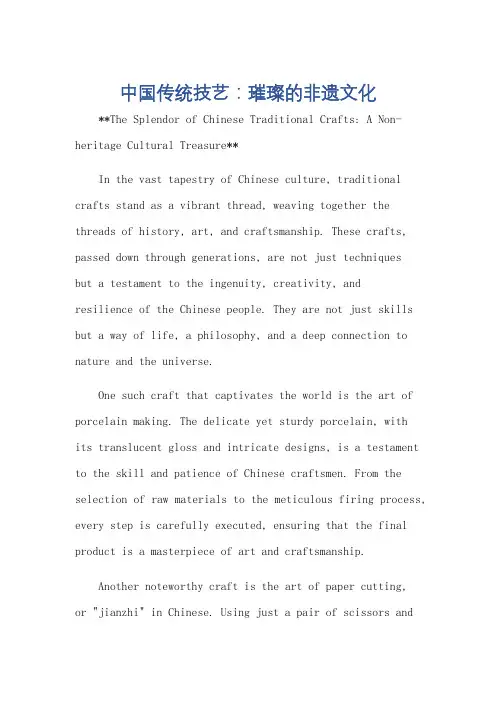
中国传统技艺:璀璨的非遗文化**The Splendor of Chinese Traditional Crafts: A Non-heritage Cultural Treasure**In the vast tapestry of Chinese culture, traditional crafts stand as a vibrant thread, weaving together the threads of history, art, and craftsmanship. These crafts, passed down through generations, are not just techniquesbut a testament to the ingenuity, creativity, andresilience of the Chinese people. They are not just skills but a way of life, a philosophy, and a deep connection to nature and the universe.One such craft that captivates the world is the art of porcelain making. The delicate yet sturdy porcelain, withits translucent gloss and intricate designs, is a testament to the skill and patience of Chinese craftsmen. From the selection of raw materials to the meticulous firing process, every step is carefully executed, ensuring that the final product is a masterpiece of art and craftsmanship.Another noteworthy craft is the art of paper cutting,or "jianzhi" in Chinese. Using just a pair of scissors anda sheet of paper, artists create intricate designs and patterns with惊人的速度和精度。
小学生英语作文中秋节的传统艺术和手工技巧(中英文翻译)中秋节是中国传统的重要节日之一,每年农历八月十五日庆祝。
在小学生的英语作文中,我们可以介绍一些关于中秋节的传统艺术和手工技巧。
下面是一些相关内容的中英文翻译。
1. 中国灯笼(Chinese Lantern)中秋节的一个传统艺术品就是中国灯笼。
灯笼由纸、竹子和丝线制成,形状各异,有红、黄、蓝等各种颜色。
人们会在中秋节晚上挂灯笼,创造出美丽的光环,这象征着团圆和幸福。
One traditional art craft of Mid-Autumn Festival in China is the Chinese lantern. The lantern is made of paper, bamboo and silk thread, in various shapes and colors such as red, yellow, and blue. People hang lanterns on the Mid-Autumn Festival night to create a beautiful atmosphere, which symbolizes reunion and happiness.2. 月饼制作(Mooncake Making)除了欣赏传统艺术品,中秋节还有一个非常有趣的手工技巧,那就是制作月饼。
月饼是一种圆形的糕点,外皮香酥,内陷丰富多样。
小朋友可以和家人一起制作月饼,将自己喜欢的馅料包裹在饼皮里。
制作月饼不仅可以欣赏家人的团聚时刻,还可以品尝美味的糕点。
In addition to appreciating traditional art crafts, there is also a fun handcraft technique during the Mid-Autumn Festival, which is making mooncakes. Mooncake is a round pastry with a crispy crust and variousfillings. Children can make mooncakes with their families and wrap their favorite fillings in the crust. Making mooncakes not only allows families to enjoy the reunion moment, but also taste delicious pastries.3. 中秋赏月(Moon Gazing)中秋节的一个重要习俗是在户外赏月。
中国传统艺术展导词英语作文高中A Trip to the Traditional Chinese Art ExhibitionHey everyone! I wanted to tell you all about this super cool exhibition I went to last weekend with my family. It was at the city museum and it was all about traditional Chinese art and culture. I know that might not sound too exciting at first, but just wait until you hear about all the awesome stuff I saw!We started off by going through these huge doors into the main exhibit hall. The first thing that caught my eye was these massive, brightly colored sculptures right in the middle of the room. They were like 10 feet tall and made out of thousands of pieces of silk sewn together. The sculptures looked kind of like dragons or mythical beasts from Chinese legends. The colors and details were just mind-blowing.My little brother thought they looked like the kaiju monsters from those crazy Japanese movies he's obsessed with. I had to laugh because he wasn't totally wrong! The craftsmen who made those silk sculptures were clearly drawing inspiration from those ancient mythological creatures.After gawking at the silk sculptures for a while, we headed over to the calligraphy section. That's the ancient Chinese art ofhandwriting and brush strokes. I'll be honest, at first I thought it would be kind of boring watching people paint words and symbols. Boy, was I wrong about that!The calligraphers were true masters and watching them work was like witnessing a carefully choreographed dance. The way they could create these bold, sweeping brushstrokes with perfect control and form was hypnotizing. Some of the completed scrolls and hangings they had on display used dozens of different inks and colors. The amount of skill and patience it must take to create those pieces is just staggering.After the calligraphy demos, we walked through a gallery filled with pottery, bronzeware, and jade carvings from all across China's history. I couldn't believe the level of detail and craftsmanship in some of those artifacts. There was this one jade sculpture of a dragon that honestly looked like it was made by machines, the lines and features were so precise and perfect. But nope, it was carved entirely by hand by some master artisan hundreds of years ago. Mind-blowing stuff.The pottery section blew me away too. You'd think a bunch of old pots and vases wouldn't be that fascinating, but the colors, designs, and glazing techniques were off the charts. The tour guide explained the different styles and artistry that went intoeach era and region's pottery. Like this one style uses thisultra-smooth black glaze that lets you see every detail of the etchings and paintings underneath. Just remarkable work.Of course, no exhibition on Chinese culture would be complete without showcasing the country's famous silk art and embroidery. They had this one room just filled with hanging scrolls and tapestries covered in the most intricate embroidered scenes. We're talking tens of thousands of tiny stitches per square inch creating these sprawling landscapes, floral patterns, and scenes from legends and myths.My eyes honestly started to cross after a while from trying to take in all those miniscule details. The amount of time and dedication it must have taken to create some of those pieces is just unfathomable. I can barely handle the tiny cross-stitch projects we do in art class!After the embroidery rooms, we walked through the traditional Chinese clothing and costume exhibit. I have to admit, I didn't think I'd be that into it at first. But once you see the lavish silk brocades, vibrant colors, and painstaking craftsmanship like gold embroidery and hand-painted details, it's pretty awesome.This one section showcased the styles of dress from imperial China's royal courts and dynasties. There were these crazyelaborate robes and dresses completely covered in embroidered dragons, phoenixes, flowers, and symbols. Just the materials alone looked insanely expensive and rich, let alone all the detailed needlework. That's not the kind of outfit you'd want to wear while eating messy snacks, if you know what I mean!Towards the end, they had a special exhibition on the traditional art of Chinese opera makeup and costumes. If you've never seen pictures of that stuff before, it's pretty wild. The makeup looks are just so bold and vibrant with those thick colored powders, penciled lines, and exaggerated features.The costumes were just as dazzling with their bright colors, elaborate headpieces, and tons of beaded fringes and embroidery. It was almost like the costumes and makeup were art pieces themselves rather than just something an actor wears on stage. I can't even imagine how long it takes to do one of those full makeup looks and get all those layers of costumes on.Honestly, by the end of the exhibition, my brain was just completely blown away by the level of patience, skill, and artistry that goes into all these traditional Chinese arts and crafts. Everything from the mind-boggling detail and symbolism in the tapestry designs to the smooth, glossy perfection of the pottery glazes just left me in awe.I have a totally newfound appreciation for how much time, effort, and careful handcrafted work goes into creating pieces like that. It's not like you can just whip up an embroidered silk tapestry or an ornate ceramic vase with dragons and phoenix symbols on a 3D printer, you know?These are centuries-old traditions passed down by master artisans dedicating their whole lives to perfecting their crafts. Just thinking about the grueling hours of work and unwavering dedication it took to make some of those pieces makes me exhausted!So if you ever get a chance to see an exhibition of traditional Chinese arts and crafts like that, I'd totally recommend going. Even if you don't think you'll be that into it at first, it's just such an eye-opening experience seeing that level of incredible skill and artistry in person. You'll walk away with a profound respect for those ancient artistic traditions and the amazing cultural heritage they represent. It's not something you really get to experience every day, that's for sure!。
介绍一种我最喜欢的中国传统艺术英语作文My Favorite Traditional Chinese Art: The Incredible Art of CalligraphyHi there! My name is Xiaoming and I'm 10 years old. Today I want to tell you all about one of my favorite traditional Chinese arts - the amazing art of calligraphy! Get ready to be wowed by this beautiful way of writing Chinese characters.What is calligraphy? It's the art of writing words and letters in a very artistic and decorative way using special brushes and ink. In Chinese calligraphy, artists use brushes to draw each character stroke by stroke on paper or other materials. It's kind of like painting words instead of just writing them quickly.Chinese calligraphy has been around for over 2,000 years! Can you believe people have been making such gorgeous writing for that long? The earliest calligraphers started using brushes made from animal hair to draw characters on things like bamboo and silk. Over time, paper became more popular and new tools like inkstones for grinding ink were invented.There are so many cool things about Chinese calligraphy that make it really special. First, the brushes! Calligraphy brushes are made from animal hair like wolf, weasel, or goat hair bundledtogether. The best ones can cost a ton of money. There are different brush sizes and shapes for different calligraphy styles too.Then there's the ink and inkstones. Traditional ink cakes are made from pine smoke soot and animal glue formed into solid pieces. To use them, you grind the ink cake on an inkstone with water to make the liquid ink. Inkstones come in all kinds of beautiful colors and patterns.But the most amazing part of calligraphy is watching the artists create the characters. It looks like such a graceful dance as they load the brush with ink and flow it across the paper leaving behind bold or delicate strokes. The characters have to be written a certain way with precise weights, shapes, and structures. That's why calligraphers practice so much - to get every stroke perfect.There are different calligraphy styles that make the characters look unique. Some styles use very clean, straight lines while cursive styles look more flowy with joined-up strokes. My favorite is the running script because the characters look so energetic and alive!Master calligraphers can produce works that are like pieces of art. The character compositions have a wonderful sense ofrhythm and balance. Plus, the contrasts between thick and thin lines add such beautiful texture. And it all happens through how the calligrapher controls the brush and uses different pressures.Calligraphy is also connected to Chinese philosophy and ways of thinking. The brushstrokes are influenced by ideas about harmony, energy flows, and being at peace. Maybe that's why watching it can feel so relaxing and meditative.In China today, calligraphy is seen as one of the highest artforms. Museums have galleries dedicated just to displaying ancient masterpieces on hanging scrolls or carved into stones. But it's not just for looking at - many people young and old still learn and practice calligraphy as a way to appreciate this tradition.I got interested in calligraphy from going to a Chinese cultural school on weekends. We start learning from a young age how to hold the brush and do basic strokes. It's really satisfying when you get the ink to flow smoothly across the paper in different thicknesses. My calligraphy isn't great yet, but I'm going to keep practicing!Calligraphy is also just plain fun. We sometimes write phrases or words that are meaningful to us like "friendship" or "strength." Splashing around with the ink and brushes is a niceway to be creative and messy. My friends and I love trying out new decorative styles and seeing whose characters look the most artistic.Well, I could go on and on about how amazing Chinese calligraphy is. From the beautiful tools and materials to the mindful way of forming each character, it's an art that has been perfected over thousands of years. I'm so lucky to learn this tradition while I'm young.If you ever get a chance, I highly recommend trying calligraphy or at least watching a master at work. You'll be hypnotized by the fluid brushstrokes that bring the characters to life. And who knows, you might just develop a new appreciation for this incredible traditional Chinese art! Let me know if you have any other questions - I'm always excited to share more about calligraphy.。
介绍一种你喜欢的传统艺术英语作文Traditional art is a form of cultural expression that has been passed down through generations. It encompasses a wide range of art forms, including painting, sculpture, music, dance, and theater. Each art form has its own unique history and techniques, and they all play an important role in preserving and promoting cultural heritage. One traditional art form that I particularly admire is Chinese calligraphy.Chinese calligraphy, also known as shufa, is a highly esteemed art form in China. It has a history of over 3,000 years and is considered a fundamental element of Chinese culture. Calligraphy is not just about writing characters; it is about expressing the inner emotions of the artist and capturing the essence of the subject matter. The brush strokes are carefully executed, and the balance and rhythm of the characters are meticulously crafted. Chinese calligraphy is not only visually appealing but also holds deep philosophical and spiritual meanings.One of the reasons why I am drawn to Chinesecalligraphy is its profound cultural significance. In Chinese culture, calligraphy is not just a means of communication; it is a reflection of one's character and inner state. The act of writing characters is seen as a form of meditation, and the quality of the calligraphy is believed to reveal the moral integrity and emotional state of the artist. This deep connection between calligraphy and the human spirit is what makes it so captivating to me.Furthermore, Chinese calligraphy is a highlydisciplined art form that requires years of practice and dedication to master. The brush strokes are carefully controlled, and the artist must have a deep understanding of the structure and meaning of the characters. It is a form of art that demands both physical and mental discipline, and the process of practicing calligraphy is considered a form of self-cultivation. The patience and perseverance required to excel in calligraphy is something that I deeply admire.In addition to its cultural and artistic value, Chinese calligraphy also has a practical aspect. Traditionally, calligraphy was used for writing official documents, recording historical events, and creating works of literature. Even today, calligraphy is still widely practiced in China and other parts of East Asia. It is often used for decorative purposes, such as hanging scrolls and inscriptions, as well as for personal expression through the writing of poems and other literary works. The versatility of calligraphy as both an art form and a practical means of communication is another reason why I find it so fascinating.Finally, Chinese calligraphy has a timeless beauty that transcends cultural and linguistic boundaries. The graceful and flowing brush strokes, the harmonious composition of characters, and the expressive energy captured in each piece of calligraphy are universally appreciated. As someone who is not of Chinese descent, I am captivated by the beauty and elegance of Chinese calligraphy, and I believe that its appeal is truly universal.In conclusion, Chinese calligraphy is a traditional art form that I deeply admire for its cultural significance, artistic discipline, practical utility, and timeless beauty. It is a form of art that has withstood the test of time and continues to inspire and captivate people around the world. The profound connection between calligraphy and the human spirit, as well as its ability to convey emotions and meanings through brush strokes, is what makes it such a cherished and revered art form. I am truly fascinated bythe depth and richness of Chinese calligraphy, and Ibelieve that it will continue to be a source of inspiration for generations to come.。
中国民间传统工艺英文Traditional Chinese folk crafts have a rich history and cultural significance. These crafts reflect the creativity, skill, and aesthetic sense of the Chinese people, passed down through generations. From pottery and paper cutting to embroidery and seal carving, each craft has its own unique charm and tells a story of Chinese tradition.One of the most renowned Chinese folk crafts is pottery. China’s long history of pottery making dates back thousands of years. Chinese potters are known for their exquisite craftsmanship and delicate designs. Porcelain, with its glossy finish and vibrant colors, is a prime example of the beauty that can be achieved through this traditional craft. The ancient technique of firing ceramics at high temperatures has been perfected in China, resulting in durable and elegant pieces.Another popular traditional craft is paper cutting, which has been practiced for centuries. Chinese paper cutting involves intricate designs being carved into paper using scissors or knives. These delicate creations are often used as decorations for festivals and celebrations. The motifs of paper cuttings vary from simple shapes to elaborate scenes depicting Chinese folklore and mythology. The skillful precision required to create these works of art is a testament to the talent and dedication of the craftsmen.Embroidery is yet another traditional craft that holds a special place in Chinese culture. Chinese embroidery is characterized by its intricate stitching and diverse styles. Each region in China has its own unique embroidery techniques and patterns. Silk threads are meticulously sewn onto fabric, creating stunning designs that often depict flowers, birds, and other natural elements. Chinese embroidery is not only visually appealing but also carries symbolic meanings, representing prosperity, luck, and happiness.Seal carving is a traditional Chinese craftsmanship that involves carving characters or designs onto stone, wood, or even bone. These seals are used to make impressions in ink, serving as signatures or official stamps. Seal carving is considered a highly skilled art form that requires both calligraphic and artistic abilities. The characters carved onto the seals can be traditional Chinese characters or personalized designs, reflecting the individuality of the owner.The preservation and promotion of these traditional folk crafts have become increasingly important in recent years. Efforts are being made to safeguard and revive these crafts by supporting artisans, organizing exhibitions, and promoting cultural exchange. By recognizing the value and significance of Chinese traditional crafts, we can ensure the preservation of this intangible cultural heritage for future generations.In conclusion, Chinese folk crafts represent a treasured part of the c ountry’s cultural heritage. Pottery, paper cutting, embroidery, and seal carving are just a few examples of the diverse range of traditional crafts that continue to be practiced today. These crafts not only embody the creativity and skill of the Chinese people but also carry deep cultural meanings. By appreciating and supporting these crafts, we can celebrate the beauty of Chinese tradition and ensure its preservation for years to come.。